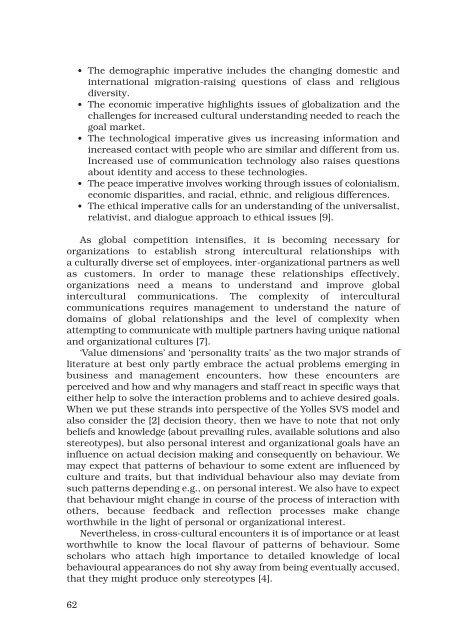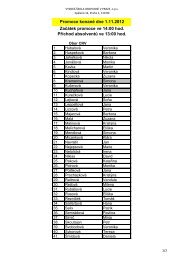Sestava 1 - Vysoká škola obchodnà v Praze
Sestava 1 - Vysoká škola obchodnà v Praze
Sestava 1 - Vysoká škola obchodnà v Praze
Create successful ePaper yourself
Turn your PDF publications into a flip-book with our unique Google optimized e-Paper software.
• The demographic imperative includes the changing domestic and<br />
international migration-raising questions of class and religious<br />
diversity.<br />
• The economic imperative highlights issues of globalization and the<br />
challenges for increased cultural understanding needed to reach the<br />
goal market.<br />
• The technological imperative gives us increasing information and<br />
increased contact with people who are similar and different from us.<br />
Increased use of communication technology also raises questions<br />
about identity and access to these technologies.<br />
• The peace imperative involves working through issues of colonialism,<br />
economic disparities, and racial, ethnic, and religious differences.<br />
• The ethical imperative calls for an understanding of the universalist,<br />
relativist, and dialogue approach to ethical issues [9].<br />
As global competition intensifies, it is becoming necessary for<br />
organizations to establish strong intercultural relationships with<br />
a culturally diverse set of employees, inter-organizational partners as well<br />
as customers. In order to manage these relationships effectively,<br />
organizations need a means to understand and improve global<br />
intercultural communications. The complexity of intercultural<br />
communications requires management to understand the nature of<br />
domains of global relationships and the level of complexity when<br />
attempting to communicate with multiple partners having unique national<br />
and organizational cultures [7].<br />
‘Value dimensions’ and ‘personality traits’ as the two major strands of<br />
literature at best only partly embrace the actual problems emerging in<br />
business and management encounters, how these encounters are<br />
perceived and how and why managers and staff react in specific ways that<br />
either help to solve the interaction problems and to achieve desired goals.<br />
When we put these strands into perspective of the Yolles SVS model and<br />
also consider the [2] decision theory, then we have to note that not only<br />
beliefs and knowledge (about prevailing rules, available solutions and also<br />
stereotypes), but also personal interest and organizational goals have an<br />
influence on actual decision making and consequently on behaviour. We<br />
may expect that patterns of behaviour to some extent are influenced by<br />
culture and traits, but that individual behaviour also may deviate from<br />
such patterns depending e.g., on personal interest. We also have to expect<br />
that behaviour might change in course of the process of interaction with<br />
others, because feedback and reflection processes make change<br />
worthwhile in the light of personal or organizational interest.<br />
Nevertheless, in cross-cultural encounters it is of importance or at least<br />
worthwhile to know the local flavour of patterns of behaviour. Some<br />
scholars who attach high importance to detailed knowledge of local<br />
behavioural appearances do not shy away from being eventually accused,<br />
that they might produce only stereotypes [4].<br />
62










